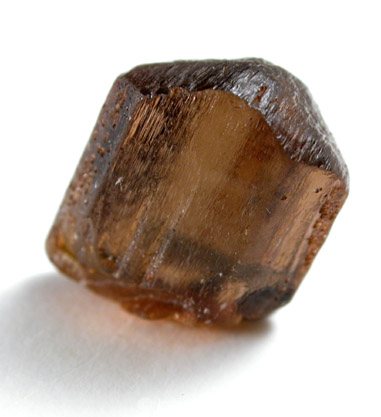The Mineral enstatite

Enstatite forms series with the rare mineral Ferrosillite (Fe2Si2O6).
Pure
Enstatite (without any at all iron) is not common, and pure
Ferrosillite (without any magnesium) is extremely rare. A common
intermediary member of this series is known as Hypersthene, with a chemical formula of
(Mg,Fe)2Si2O6.
Although the term Hypersthene has been discredited by the IMA in
1998, it is still commonly used by many reference guides and is labeled as such in many collections.
Pure Enstatite is transparent and lightly colored; the iron content is responsible for the darker colors and increased opacity.
Chemical Formula
Mg2Si2O6
Color
Gray, green, dark yellow, yellow-brown, greenish-brown, brown, black
Crystal System
Orthorhombic
Properties
Streak
Light brown to grayish-white |
Hardness
5 - 6 |
Transparency
Transparent to opaque |
Specific Gravity
3.1 - 3.9 |
Luster
Vitreous, silky, dull |
Cleavage
1,2 - prismatic at cleavage angles of 87º and 93º
(Characteristic of minerals in the pyroxene group). May also exhibit parting in one direction. |
Fracture
Uneven |
Tenacity
Brittle |
Varieties
-
Deep forest-green, chromium-rich variety of Enstatite.
-
Iron-rich variety of Enstatite, which was historically classified as an individual mineral species until 1998, when it was discredited by the IMA. The chemical form of Hypersthene is (Mg,Fe)2Si2O6.
Uses
The variety Bronzite is used as a minor gemstone. It often contains inclusions of highly reflective minerals, such as Hematite and Goethite, which give it a bronze-like effect when polished (hence its name). Polished Bronzite may also exhibit asterism or cat's eye effect.
Noteworthy Localities
A classic Bronzite occurrence is the chrome mines of Kraubath, Styria, Austria. Small, transparent crystals come from Mont-Dore, Auvergne, France; and an exceptionally gemmy olive-green form comes from Mogok, Mynamar (Burma); and from the Kilosa District, Morogoro, Tanzania.
In the U.S., localities include the the Tilly Foster Mine, Brewster, Putnam Co., New York; Gore Mountain, Warren Co., New York; the Wood's Chrome Mine, Texas, Lancaster Co., Pennsylvania; Summit Rock, Klamath Co., Oregon; and Nain, Labrador, Canada.
Good Bronzite comes from the Bare Hills, Baltimore Co., Maryland; and Webster, Jackson Co., North Carolina.
Distingushing Similar Minerals
Hornblende - Different cleavage angles (otherwise difficult to distinguish).
Diopside and Augite - Very difficult to distinguish.